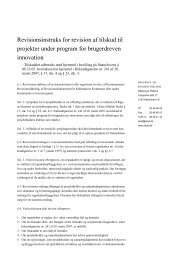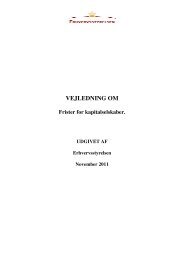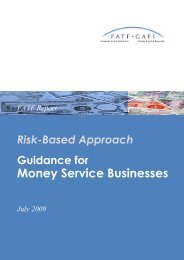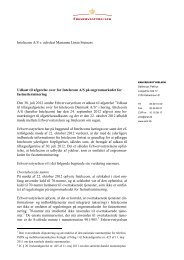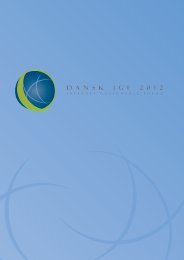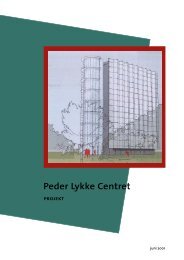RBA Guidance for Real Estate Agents.pdf - FATF
RBA Guidance for Real Estate Agents.pdf - FATF
RBA Guidance for Real Estate Agents.pdf - FATF
Create successful ePaper yourself
Turn your PDF publications into a flip-book with our unique Google optimized e-Paper software.
SECTION THREE:GUIDANCE FOR REAL ESTATE AGENTSON IMPLEMENTING A RISK-BASED APPROACHChapter One: Risk Categories105. In order to implement a reasonable risk-based approach, real estate agents should identify thecriteria to assess potential money laundering and terrorist financing risks. Identification of the moneylaundering and terrorist financing risks, to the extent that such terrorist financing risk can be identified, ofcustomers or categories of customers, and transactions will allow real estate agents to determine andimplement proportionate measures and controls to mitigate these risks.106. Money laundering and terrorist financing risks may be measured using various categories.Application of risk categories provides strategy <strong>for</strong> managing potential risks by enabling real estate agentsto subject customers to proportionate controls and oversight. The most commonly used risk categories are:country or geographic risk, customer risk, and transaction risk. The weight given to each category(individually or in combination) in assessing the overall risk of potential money laundering and terroristfinancing may vary from one real estate agent to another, depending upon their respective circumstances.Consequently, real estate agents will have to make their own determination regarding risk weighting.Parameters set by law or regulation may limit a real estate agent’s discretion.107. While there is no agreed upon set of risk categories <strong>for</strong> real estate agents, the examples providedherein are the most commonly identified risk categories. There is no one single methodology to apply theserisk categories, and the application of these risk categories is intended to provide a strategy <strong>for</strong> managingpotential risks. The following risk categories can indicate a higher risk of money laundering or terroristfinancing, dependent upon all of the surrounding circumstances, taking into account the norms of themarket at any given time.Country/geographic risk108. Potential elements contributing to risk include:• Location of property(s) in relation to the buyer. Different countries pose different levels and typesof risks pertaining to cross border, non-face to face transactions, e.g. some countries have higher orlower levels of criminality and/or regulation.• Location of the buyer and seller.109. There is no universally agreed definition by either competent authorities, SROs, or real estateagents that prescribes whether a particular country or geographic area represents a higher risk. Countryrisk, in conjunction with other risk factors, provides useful in<strong>for</strong>mation as to potential money launderingand terrorist financing risks. Factors that may result in a determination that a country poses a higher riskinclude:20








